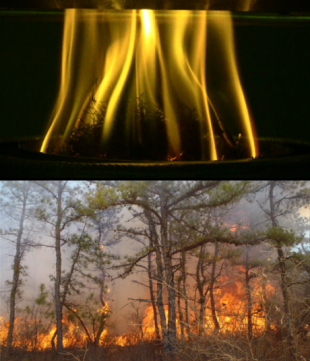This is a highly collaborative and multidisciplinary effort and the contribution of the University of Edinburgh is focused on detailed investigation of the processes of heat transfer and thermal degradation at the scale of individual fuel particles and small fuel beds. Activities related to the first of these include the development of a heated wind tunnel. This is used to quantify drag forces in fuel matrixes of various compositions and porosities, as well as to understand how the associated flow characteristics influence the convective heating of fuel particles – one driver of particle degradation and ignition. Tests of fuel particle heating with radiant panels are used to explore the role of thermal radiation – another driver. Additionally, highly instrumented tests of flame spread on small fuel beds allow an assessment of the interaction of the two drivers, which were previously decoupled. Finally, robust and easily deployable instrumentation is being developed for measurement of flow and heat transfer in field-scale fire experiments, so that the relevancy of experimental conditions in the laboratory can be assured.
Activities related to the second aspect, thermal degradation will shed light on the response of the relevant fuel materials to the aforementioned heating mechanisms. Laboratory tests include bomb calorimetry; hot plate conductivity measurements; TGA and DSC analysis of pyrolysis and oxidation kinetics; and measurement of critical heat fluxes, effective heats of combustion, radiative fractions, etc. with the Fire Propagation Apparatus. These tests not only shed light on the processes that ultimately result in fuel consumption, but serve to provide valuable parameters for numerical modeling purposes.
All of the experimental measurement described above is carried out in parallel with the development and testing of a physics-based model that explicitly accounts for combustion, turbulent transfer, and energy exchange by coupling and scaling individual component processes – the Fire Dynamics Simulator (FDS). The development of this tool is a primary motivation for the work, and while the ultimate goal is to apply it at a scale relevant to the field, simulations of laboratory scale experiments are invaluable. By isolating various processes, these allow specific sub-models, which are needed to close the underlying system of equations, to be evaluated. These sub-models employ various physical and numerical approximations and assumptions, and their robustness should be demonstrated in order to apply them with confidence to the complex scenario of low-intensity fires at large scale.
- Other PIs:
- Nick Skowronski, USDA Forest Service
- Warren Heilman, USDA Forest Service
- William Mell, , USDA Forest Service
- Kenneth Clark, USDA Forest Service
- John Hom, USDA Forest Service
- Jay Charney, USDA Forest Service
- Michael Gallagher, USDA Forest Service
- Albert Simeoni, Worcester Polytechnic Institute
- Seong-kyun Im, University of Notre Dame
- Robert Kremens, Rochester Institute of Technology
Further Information:
Sponsored by the Strategic Environmental Research and Development Program (SERDP)
Principal Investigator:
Postgraduate Researchers:
Eric Mueller – PDRA
Carlos Walker-Ravena – PhD student



